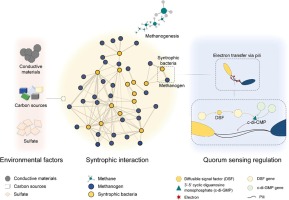Environment International ( IF 10.3 ) Pub Date : 2020-03-14 , DOI: 10.1016/j.envint.2020.105650 Qidong Yin , Mengqi Gu , Slawomir W. Hermanowicz , Hongying Hu , Guangxue Wu

|
Interspecies electron transfer plays an important role in syntrophic methanogenesis. Direct interspecies electron transfer (DIET) between syntrophic oxidizers and methanogens via conductive pili has been only confirmed in some specific co-cultures. This study examined potential syntrophic cooperation via type IV pili and quorum sensing between widespread syntrophic bacteria and methanogens through a metagenomic analysis of 12 anaerobic sludge samples. We found that Methanosaeta and Methanosarcina, which are reported to have DIET ability, were dominant in most methanogenic samples. Putative conductive pili genes were found in some typical syntrophic bacteria, which has rarely been reported previously. The existence of diverse quorum-sensing genes suggested that various quorum-sensing systems might participate in the communication of anaerobic microorganisms. Specifically, the diffusible signal factor and 3′-5′ cyclic diguanosine monophosphate related genes were mainly assigned to syntrophic bacteria. These results suggest that the combined regulation of these signals might be responsible for the biosynthesis of type IV pili and affect syntrophic interaction during methanogenesis. These novel results provide fresh evidence to support the widespread existence of DIET in anaerobic methanogenic systems; therefore, regulating the quorum-sensing system may promote syntrophic interaction.
中文翻译:

通过IV型菌毛和群体感应系统,营养细菌和产甲烷菌之间的潜在相互作用
种间电子转移在同养甲烷化中起重要作用。仅在某些特定的共培养物中,通过导电菌毛在同养型氧化剂和产甲烷菌之间进行直接种间电子转移(DIET)。这项研究通过对12个厌氧污泥样品的宏基因组分析,研究了通过IV型菌毛和群体感应在广泛的同养细菌和产甲烷菌之间的潜在同养合作。我们发现甲烷菌和甲烷菌据报道具有DIET能力,在大多数产甲烷样品中占主导地位。在一些典型的营养菌中发现了推测的导电菌毛基因,以前很少报道。多种群体感应基因的存在表明各种群体感应系统可能参与厌氧微生物的交流。具体地,可扩散信号因子和3'-5'环状双鸟嘌呤单磷酸相关基因主要分配给营养菌。这些结果表明,这些信号的联合调节可能负责IV型菌毛的生物合成,并影响产甲烷过程中的营养间相互作用。这些新颖的结果提供了新的证据来支持DIET在厌氧产甲烷系统中的广泛存在。因此,











































 京公网安备 11010802027423号
京公网安备 11010802027423号